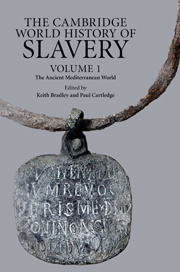Book contents
- Frontmatter
- Contents
- Series editors' introduction
- List of figures
- Acknowledgements
- Introduction
- 1 Slavery in the ancient Near East
- 2 Slaves in Greek literary culture
- 3 Classical Athens
- 4 The Helots: a contemporary review
- 5 Slavery and economy in the Greek world
- 6 The slave supply in classical Greece
- 7 Slavery and the Greek family
- 8 Resistance among chattel slaves in the classical Greek world
- 9 Archaeology and Greek slavery
- 10 Slavery in the Hellenistic world
- 11 Slavery and Roman literary culture
- 12 Slavery in the Roman Republic
- 13 Slavery Under the Principate
- 14 The Roman slave supply
- 15 Slave labour and Roman society
- 16 Slavery and the Roman family
- 17 Resisting slavery at Rome
- 18 Slavery and Roman material culture
- 19 Slavery and Roman law
- 20 Slavery and the Jews
- 21 Slavery and the rise of Christianity
- 22 Slavery in the late Roman world
- Bibliography
- General index
- Index of ancient passages cited
- Index of inscriptions and papyri
- Index of Jewish and Christian Literature Cited
13 - Slavery Under the Principate
Published online by Cambridge University Press: 28 September 2011
- Frontmatter
- Contents
- Series editors' introduction
- List of figures
- Acknowledgements
- Introduction
- 1 Slavery in the ancient Near East
- 2 Slaves in Greek literary culture
- 3 Classical Athens
- 4 The Helots: a contemporary review
- 5 Slavery and economy in the Greek world
- 6 The slave supply in classical Greece
- 7 Slavery and the Greek family
- 8 Resistance among chattel slaves in the classical Greek world
- 9 Archaeology and Greek slavery
- 10 Slavery in the Hellenistic world
- 11 Slavery and Roman literary culture
- 12 Slavery in the Roman Republic
- 13 Slavery Under the Principate
- 14 The Roman slave supply
- 15 Slave labour and Roman society
- 16 Slavery and the Roman family
- 17 Resisting slavery at Rome
- 18 Slavery and Roman material culture
- 19 Slavery and Roman law
- 20 Slavery and the Jews
- 21 Slavery and the rise of Christianity
- 22 Slavery in the late Roman world
- Bibliography
- General index
- Index of ancient passages cited
- Index of inscriptions and papyri
- Index of Jewish and Christian Literature Cited
Summary
INTRODUCTION
The slave society of Roman Italy, characterised by the presence of large numbers of slaves (forming perhaps as much as 35 per cent of the population) in all kinds of activity from personal service to crafts to business to education, and in all regions and all levels of society from the depths of the countryside to the houses of the urban elite, developed over the course of the last two centuries bc. Over this same period, slave labour maintained a central role in agricultural production, in the market-orientated villa system of central Italy described by Cato and Varro; slaves were by no means the only people involved in productive activity, or even the majority, but they played a vital role in accumulating the marketable surpluses that sustained the lifestyles and ambitions of many of the elite. Their role in ensuring the social reproduction of the elite, both through apparently unproductive' personal services (which in fact were vital for their owners' participation in the competition for status and the display of an ‘appropriate’ lifestyle) and through their dominant position in the process of educating and socialising the next generation of aristocrats, should also not be underestimated. Indeed, in a family environment that was characterised, as Bradley (1991a: 125–55) has argued, by a high risk of emotional uncertainty and dislocation, slave tutors and nurses offered some degree of continuity in personal relationships for young aristocrats, and so, perhaps, shaped the behaviour of generations of elite Romans.
- Type
- Chapter
- Information
- The Cambridge World History of Slavery , pp. 265 - 286Publisher: Cambridge University PressPrint publication year: 2011
- 21
- Cited by

